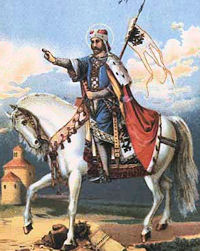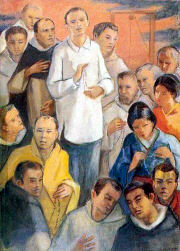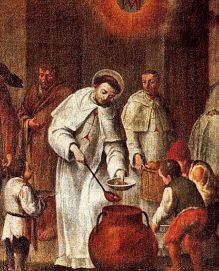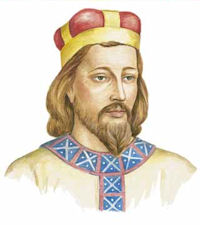Ordinary Time: September 28th
Optional Memorial of St. Wenceslaus, martyr; St. Lawrence Ruiz and Companions, martyrs
Other Commemorations: St. Simon de Rojas, Priest (RM) ; Other Titles: Wenceslas; Vaclav; Wenzel; Vaceslav; Wenceslaus of Bohemia; Lorenzo Ruiz; Laurence Ruiz;
» Enjoy our Liturgical Seasons series of e-books!
St. Wenceslaus was Duke of Bohemia, who after many trials in governing and evangelizing his people, suffered martyrdom at the hands of his brother.
In the 17th century (1633-1637) St. Lawrence Ruiz and his companions shed their blood for Christ in Nagasaki, Japan. These martyrs were members of the Order of St. Dominic. They were nine priests, two religious, two sisters, and three laymen. Among the latter was Lawrence Ruiz, a family man from the Philippines. They abundantly sowed the missionary seed of Christianity with the example of their life and death.
Historically today is the feast of St. John of Dukla who was born in Dukla, Poland in 1414. He joined the Friars Minor Conventual, a religious order who strictly adhered to their rule of poverty and obedience. Though he went blind later in age he was able to prepare sermons with the help of an aide. His preaching was credited in bringing people back to the Church in his province. Soon after his death, there was an immediate at his tomb and several miracles were attributed to him. On June 10, 1997, he was canonized by Pope John Paul II in a mass at Krosno, Poland before approximately one million people.
St. Wenceslaus
St. Wenceslaus, duke of Bohemia, was born about the year 907 at Prague, Bohemia (now the Czech Republic). His father was killed in battle when he was young, leaving the kingdom to be ruled by his pagan mother. Wenceslaus was educated by his grandmother, Ludmilla, also a saint. She taught him to be a Christian and to be a good king. She was killed by pagan nobles before she saw him king, but she left him with a deep committment to the Christian faith.
 Throughout his life he preserved his virginity unblemished. As duke he was a father to his subjects, generous toward orphans, widows, and the poor. On his own shoulders he frequently carried wood to the houses of the needy. He often attended the funerals of the poor, ransomed captives, and visited those suffering in prison. He was filled with a deep reverence toward the clergy; with his own hands he sowed the wheat for making altar breads and pressed the grapes for the wine used in the Mass. During winter he would visit the churches barefoot through snow and ice, frequently leaving behind bloody footprints.
Throughout his life he preserved his virginity unblemished. As duke he was a father to his subjects, generous toward orphans, widows, and the poor. On his own shoulders he frequently carried wood to the houses of the needy. He often attended the funerals of the poor, ransomed captives, and visited those suffering in prison. He was filled with a deep reverence toward the clergy; with his own hands he sowed the wheat for making altar breads and pressed the grapes for the wine used in the Mass. During winter he would visit the churches barefoot through snow and ice, frequently leaving behind bloody footprints.
Wenceslaus was eighteen years old when he succeeded his father to the throne. Without regard for the opposition, he worked in close cooperation with the Church to convert his pagan country. He ended the persecution of Christians, built churches and brought back exiled priests. As king he gave an example of a devout life and of great Christian charity, with his people calling him "Good King" of Bohemia.
His brother Boleslaus, however, turned to paganism. One day he invited Wenceslaus to his house for a banquet. The next morning, on September 28, 929, as Wenceslaus was on the way to Mass, Boleslaus struck him down at the door of the church. Before he died, Wenceslaus forgave his brother and asked God's mercy for his soul. Although he was killed for political reasons, he is listed as a martyr since the dispute arose over his faith. This king, martyred at the age of twenty-two, is the national hero and patron of the Czech Republic. He is the first Slav to be canonized.
Patronage: brewers; Bohemia; Czech Republic; Moravia; Czechoslovakia; Slovakia; city of Prague, Czech Republic; archdiocese of Prague, Czech Republic
Symbols and Representation: Armor; corn; black eagle; coffin held by angels; sword and purse; red banner charged with a white eagle; banner; staff; eagle on shield.
Highlights and Things to Do:
- Read more about St. Wenceslas:
- Learn more about Prague and the Czech Republic and St. Vitus Cathedral, supposedly started by St. Wenceslas in the 10th century as a small chapel to house relics of St. Vitus and were in the 14th century St. John Nepomucene was buried after being executed for refusing to violate the seal of the confessional.
- See the Altar of St. Wenceslas in St. Peter's Basilica.
- Sing with your children the Christmas carol, Good King Wenceslas and discuss his life and virtue. If you can find a copy, a wonderful book with music and illustrations is called Good King Wenceslas: A Legend in Music and Pictures by Mary Reed Newland, published by Seabury Press, 1980. There are many other picture books that depict the Christmas Carol with pictures.
- Read about the Infant Jesus of Prague and pray the chaplet.
- Bake a loaf of bread for dinner and serve Pilsner beer in honor of St. Wenceslas. See also Catholic Cuisine for other ideas.
St. Lawrence Ruiz
 Lawrence Ruiz is the first Filipino to be canonized a saint. He and 15 others were martyred at Nagasaki, Japan in 1637. The group included two consecrated women, two other laymen, two brothers and nine priests.
Lawrence Ruiz is the first Filipino to be canonized a saint. He and 15 others were martyred at Nagasaki, Japan in 1637. The group included two consecrated women, two other laymen, two brothers and nine priests.
Lawrence was born in Manila in the Philippines; his father was Chinese and his mother Filipino. He became associated with the Dominicans, and was a member of the Confraternity of the Holy Rosary. These Dominicans taught him Spanish, and from his parents he learned Chinese and Tagalog. He became a professional calligrapher and transcribed documents.
He married and had three children. In 1636, he fled the Philippines after being accused of murder. He joined a missionary group headed for Japan, where Catholics were being persecuted. It was soon found out that the members of this group were Catholic, so they were arrested and taken to Nagasaki. They were tortured for several days, first crushed while hanging upside down for three days, then the bodies were burned, with the ashes thrown into the Pacific Ocean on September 30, 1637. Pope John Paul II canonized these martyrs on October 18, 1987.
Symbols and Representation: martyr's crown; palm frond.
Highlights and Things to Do:
- Read more about St. Lawrence and his companions:
- Find out more about the Confraternity of the Holy Rosary.
- Read more about the Church in Japan.
St. Simón de Rojas O.SS.
Father Simón de Rojas of the Trinitarian Order was born at Valladolid, Castilla, Spain, the 28th of October, 1552. At twelve years of age, he entered the Trinitarian monastery of the city where he was born and there made his religious profession on October 28, 1572; he studied at the University of Salamanca from 1573 to 1579; he was ordained a priest in 1577; he taught philosophy and theology at Toledo from 1581 to 1587; from 1588 until his death he fulfilled with much prudence the office of superior in various monasteries of his province and was sent as apostolic visitor twice to his own province of Castilla, and once to that of Andalusia; on April 14, 1612 he founded the Congregation of the Slaves of the Sweet Name of Mary; in 1619 he was named tutor to the royal princes of Spain; on May 12, 1621 he was elected Provincial of Castilla; on January 1, 1622 he was chosen confessor of Queen Isabel of Borbon; he died on September 29, 1624.
 It was his mother, the virtuous Constanza, who instilled and helped grow in the soul of Simon the love of Mary. The veneration that she and her husband Gregorio constantly gave to Mary, makes it easily understandable why the first words that Simon, who had been a slow learner and stuttered, said at the age of fourteen months, were "Ave, Maria". He was only repeating the prayer so frequently recited by his parents.
It was his mother, the virtuous Constanza, who instilled and helped grow in the soul of Simon the love of Mary. The veneration that she and her husband Gregorio constantly gave to Mary, makes it easily understandable why the first words that Simon, who had been a slow learner and stuttered, said at the age of fourteen months, were "Ave, Maria". He was only repeating the prayer so frequently recited by his parents.
His greatest joy was to visit Marian shrines, to pray to Mary and with Mary, to imitate her virtues, to sing her praises, to acknowledge her importance in the mystery of God and of the Church. Through profound theological studies, he came to understand even better the mission of Mary in cooperation with the Trinity for the salvation of the human race and the sanctification of the Church. He lived his religious vows in the imitation of Mary. He held that, for everyone to be completely of God, as Mary had been, it was necessary to become her slaves, or better, slaves of God in Mary; for this reason he established the Congregation of the Slaves of Mary for the greater glory of the Trinity, in praise of the Virgin, in the service of the poor. For him, to be a slave of Mary meant belonging totally to her: "Totus tuus" in order to unite oneself more intimately to Christ and in Him through the Spirit, to the Father.
The Congregation founded by him was intended for the laity: persons of every social class could join. The members, who included the King and his children, dedicated themselves to honor Mary by giving maternal help to her favorite children: the poor. This work still continues in Spain. Fr. Simon, who is held to be one of the greatest contemplatives of his time and who in his work, "The Greatness of Prayer" is clearly a great instructor of prayerful souls, wanted the contemplative dimension joined to the active through works of mercy. Faithful to the Trinitarian charism, he promoted the ransom of captives, he helped relieve the many needs of the poor, he consoled the sick, the destitute and the left-out of every kind. He accepted duties at the Court, only on the condition that he be able to continue his work with the poor, whom he helped in a thousand ways, always with a smile on his face and at any hour of the day or night. The expressions of his love of Mary are manifold. The painters who depicted him, put the greeting "Ave Maria" on his lips, words he uttered so frequently that he was familiarly called: "Father Ave Maria". He had thousands of images of the Most Holy Virgin printed with the inscription: "Ave Maria", which he also sent abroad. He had rosaries made with seventy-two blue beads on a white cord, symbols of the Assumption and the Immaculate Conception, and also a reminder that Mary, according to the belief of the time, lived to the age of 72 years. He sent these rosaries everywhere, even to England. Using his influence at Court, he had the angelic greeting so dear to him, "Ave Maria", engraved in letters of gold on the facade of the royal palace in Madrid. On June 5th, 1622, he petitioned the Holy See for the approval of his liturgical text composed in honor of the Sweet Name of Mary, which later, Pope Innocent XI extended to the universal Church.
After his death on September 29th, 1624, the honors bestowed on him at his funeral, took on the aspect of an anticipated canonization. For twelve days, the most reknown preachers of Madrid exalted his virtues and his holiness. Impressed with this unanimous veneration, on October 8th, shortly after Fr. Simon's death, the Papal Nuncio ordered the beginning of the process leading to his glorification by the Church. His heroic virtues were recognized by Clement XII, on March 25th, 1735; he was beatified by Clement XIII on March 19, 1766; and on July 3rd, 1988, just before the close of the Marian Year, Pope John Paul 11, entered the name of this great servant of Mary and Father of the poor on the list of the Saints.
—©Libreria Editrice Vaticana
Highlights and Things To Do:
- Read more about St. Simon:






